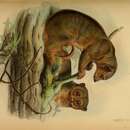en
names in breadcrumbs


For a detailed analysis of mitochondrial DNA of S. celebensis see the work of Ruedas and Morales (2005). For a detailed analysis of morphological and skeletal analysis of S. celebensis see the work of Crosby and Norris (2003). For a detailed analysis of museum study skins and skeletons of S. celebensis and its subspecies see the work of Groves (1987).
Little is known about communication in Little Celebes cuscuses. Like most nocturnal mammals they are likely to use chemical cues (smells) and hearing extensively. Cuscuses have large eyes to help them see in low light.
Communication Channels: chemical
Perception Channels: visual ; tactile ; acoustic ; chemical
The status of S. celebensis is uncertain. According to IUCN S. celebensis is data deficient, there is not enough information to determine population status.
US Federal List: no special status
CITES: no special status
State of Michigan List: no special status
IUCN Red List of Threatened Species: vulnerable
Little Celebes cuscuses are sometimes considered household pests. They tend to be found in suburban areas and are known to eat plants from gardens and to nest in roofs.
Negative Impacts: crop pest; household pest
Little Celebes cuscuses are an important source of meat for people in New Guinea and are widely hunted. In some areas of Indonesia, such as the Sula Islands in the Western Moluccas, cuscuses are not eaten in accordance with religious beliefs. Little Celebes cuscuses help to disperse fruiting tree seeds.
Positive Impacts: food
Because of their frugivorous diet S. celebensis help the ecosystem by dispersing seeds.
Ecosystem Impact: disperses seeds
Mutualist Species:
Little Celebes cuscuses are presumed to be primarily frugivorous, based on their morphology and the diet of other cuscuses. Other species of cuscus include leaves, fruits, flowers, bark, pollen, and fungi in their diets.
Plant Foods: leaves; roots and tubers; wood, bark, or stems; seeds, grains, and nuts; fruit; pollen; flowers
Other Foods: fungus
Primary Diet: herbivore (Frugivore )
Strigocuscus celebensis occurs exclusively on Sulawesi and surrounding islands. Subspecies of S. celebensis occur throughout this range: S. c. celebensis is found in southern and central Sulawesi, S. c. feileri is found in north Sulawesi, and S. c. sangirensis is found on the Sangihe Islands north of Sulawesi.
Biogeographic Regions: australian (Native )
Other Geographic Terms: island endemic
Strigocuscus celebensis occurs in rainforests and in secondary forests and gardens around human dwellings.
Habitat Regions: tropical ; terrestrial
Terrestrial Biomes: forest ; rainforest
Other Habitat Features: suburban ; agricultural
The lifespan of S. celebensis is unknown. Other species of cuscus are known to live 3 to 11 years in captivity.
Little Celebes cuscuses have an overall pale buff coloration, lacking a dorsal stripe, and the tail is partially naked part. They are small possums, weighing 1 kg or less. Head and body length is 294 to 380 mm and tail length is 270 to 373 mm. The rostrum is narrower than other phalangerids, the lachrymal is retracted from the face, the ectotympanic is almost totally excluded from the anterior face of the postglenoid process, and the third upper premolar is set at a more oblique angle relative to the molar row than it is in other phalangerids. Little Celebes cuscuses are also characterized by the large size of the third upper premolar, a widening of the zygomatic arches at the orbits, and short paroccipital processes.
Average mass: 1 kg.
Range length: 294 to 380 mm.
Other Physical Features: endothermic ; homoiothermic; bilateral symmetry
Sexual Dimorphism: sexes alike
Little information is known on possible predators of S. celebensis. It is assumed they have a limited number due to their arboreal lifestyle. Other species of cuscus are eaten by humans and New Guinea singing dogs.
Known Predators:
Little Celebes cuscuses are monogamous and occur in pairs.
Mating System: monogamous
Female S. celebensis have a forward-oriented pouch with two to four teats. Little Celebes cuscuses generally produce one to two litters per year, up to three to four young may be born, but only one is usually reared. Gestation is 20 days or less and young are born very small and unfurred.
Breeding interval: Little Celebes cuscuses generally produce one to two litters per year.
Range number of offspring: 1 to 4.
Average number of offspring: 1.
Average gestation period: 20 days.
Range weaning age: 5 to 8 months.
Key Reproductive Features: iteroparous ; year-round breeding ; gonochoric/gonochoristic/dioecious (sexes separate); sexual ; viviparous
Infant S. celebensis exit their mother's pouch between five and eight months after birth, after which they are carried on their mother’s back.
Parental Investment: altricial ; pre-fertilization (Provisioning, Protecting: Female); pre-hatching/birth (Provisioning: Female, Protecting: Female); pre-weaning/fledging (Provisioning: Female, Protecting: Female); pre-independence (Provisioning: Female, Protecting: Female)